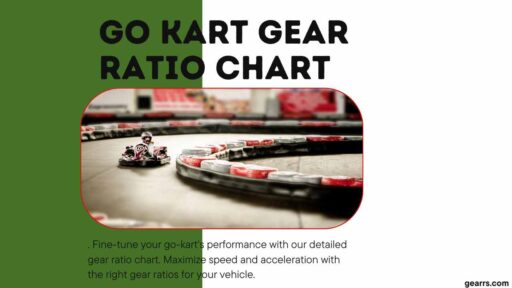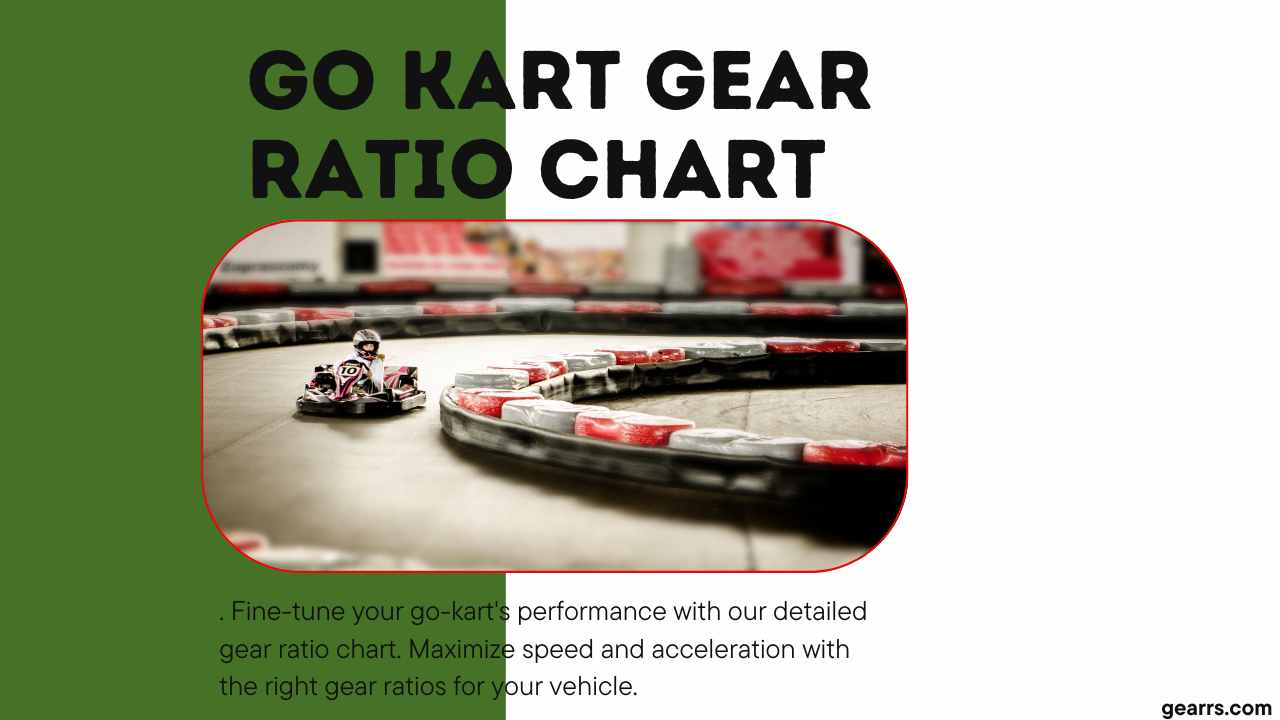Explore our comprehensive Go Kart Gear Ratio Chart for optimal performance on the track. Find the perfect gear ratio for your karting needs.
The thrill is achieved when the engine’s power harmonizes with propelling your kart at just the right speed. But which one could be the unsung hero in improving your go-kart performance? What role does a go kart gear ratio chart play while navigating through a track maze?
For both amateur and veteran racers, gear ratios are of great importance for going after their victory. In this article, we will switch on the ignition switch to knowledge. Get ready to learn about, calculate, and adjust gear ratio chart of your go kart, in order to extract all possible energy from it.
Introduction to Go Kart Gear Ratio Chart
Comprehending each bolt and screw of a car as an enthusiast is quite paramount. One of these essential aspects being considered here is go kart gear ratio. The transmission of engine output to wheels relies on this principle thus affecting acceleration and maximum speed of a kart realized. This piece provides you with basic steps that you can follow in order to get started unraveling the go-kart gear ratio chart.
Understanding the go-kart gear ratio chart
But before we can jump into optimization, we have to understand what are gear ratios and how they affect our performance in Go-Karting. Put simply, it is a comparison between two gears as regards their teeth number: for instance, turning 1 wheel twice drives another wheel around four times; therefore its mechanical advantage relative to that; is said by the other name – “gear ratio.”
As such different configurations can be made based on either high speeds or high torques required in Go-Karting. Depending on given situations relating to tracks and types of driving styles you could optimize such ratios for your equipment. Less time of inertia was perfect for accelerating out corners from rest but bad for sustaining velocity at a high rate while higher rates were better in straight-always.
Importance of gear ratio in go-kart performance
Gear Ratio plays an important role when it comes to defining how well your go-kart will perform. Higher gear ratios (e.g. 4:1) result in more torque and acceleration, but lower top speed whereas a lower gear ratio (e.g.,3:1) gives you a higher maximum speed with low torque. You can optimize your kart’s performance to suit different track conditions and driving styles by choosing an appropriate gear ratio for your needs.
kart go kart gear ratio chart
Here’s a sample go-kart gear ratio chart, but remember the actual values will vary depending on factors like engine type and track:
| Front Sprocket Teeth | Rear Sprocket Teeth | Ratio |
| 40 | 60 | 1.50 |
| 41 | 60 | 1.46 |
| 42 | 60 | 1.43 |
| 43 | 60 | 1.40 |
| 44 | 60 | 1.36 |
| 45 | 60 | 1.33 |
| 46 | 60 | 1.30 |
| 47 | 60 | 1.28 |
| 48 | 60 | 1.25 |
| 49 | 60 | 1.22 |
| 50 | 60 | 1.20 |
Factors to consider when selecting go kart gear ratio chart
When choosing gears for go-karts there are several aspects that should be looked at. The first aspect is the type of track layout. Each race course requires varying ratios for optimal performance. In addition, we should take into account engine power dynamics or torque curves when making the correct selection. Engines with more horsepower would cope well with taller gears while those with low horsepower need short gears instead. Lastly, personal preferences as well as style of driving also determine what kind of gear ratios one chooses.
How to calculate gear ratios for go-karts
Getting the correct gear ratio isn’t a matter of guesswork it is science. Here is a basic formula that will help you determine your ideal gear ratio:
- R = (N1 / N2) x D1 ÷ D2`
- N1 = Number of teeth on drive gear (usually clutch or axle gear).
- N2 = Number of teeth on driven gear (commonly engine gear).
- D1 = Diameter of the driven gear.
- D2 = Diameter of the drive gear.
This formula will give you the best ratio for your kart. For instance, a 10-teeth clutch that runs a 60-tooth axle, with a diameter of 4 inches for the clutch and 12 inches for the axle might mean R is equal to five: one.
Common Gear Ratio Setups for Different Tracks
There is no single answer to this, but here are some typical gear ratio setups used in different go-kart tracks:
Technical Tracks with Tight Corners
- Focus: Acceleration out of corners takes priority over other things.
- Typical Gear Ratio: A lower ratio (e.g. 8:42 or 9:44) than the driver sprocket has more teeth compared to the driven sprocket helps provide more torque and quicker starts.
- Mid-Speed Tracks with a Mix of Corners and Straights:
- Focus: Attain good top speed down straights while accelerating fairly fast into corners
- Typical Gear Ratio: Mid-range ratios (e.g., 7:44 or 8:46). This gives average power as well as decent pulling ability at high speeds when not cornering.
High-Speed Tracks with Long Straights:
Focus: Increasing top speed on long straight sections
Typical Gear Ratio: Higher ratios(e.g.6:44 or 7:42). It allows the motor to reach higher RPMs and achieve faster overall speeds.
Other Things to Consider Include:
Weather Conditions – Wet tracks may need a slightly lower ratio geared towards increased traction during takeoff;
Tire Sizes – Changes in tire size can affect effective ideal transmission hence making it necessary to adjust;
Engine Capabilities – The kind of power output that an engine can generate must be factored in. For instance, a less powerful engine may require lower gear ratios even at bigger tracks just to make sure it remains competitive.
Important:
These are general recommendations only. The best gear ratio for your kart will depend on the specific factors mentioned above.
To pick an ideal gear ratio setup, consult experienced racers or mechanics from your track.
It is important that during practice sessions one should experiment and test different gear ratios in order to know the correct combination that gives good lap times and performs well overall for his particular type of kart and track.
Tips on Optimizing Go Kart Gear Ratios
This will help you optimize go-kart gear ratios so as to achieve peak performance:
Understand Your Track and Your Needs
- Track Layout – The first thing is to study what kind of track you are going to race on. Is this a technical track with tight corners or does it have both corners and straights or high-speed straightaways?
- Prioritize Needs: Consider whether acceleration out of corners or top speed along straights is more important based on the layout of the circuit
- Driving Style – At the same time take into account your driving style preferences. Do you like quick starts with aggressive cornering or keeping momentum up through long straights?
Research and Analysis
Common Setups: Find out some commonest ideal gear ratios for your kart class type as well as its specific track; this could easily be searched online, through manual books, or by asking various racers who knew about such a place.
Engine Capacity: Consider the power output of your engine. It is possible for a weaker engine to benefit from a smaller gear ratio even on large tracks to enable it to remain in contention.
Fine-Tuning and Experimentation
- Start with a Baseline
Begin with a mid-range gear ratio that is a good starting point based on research and recommendations for your type of track.
- Test and Adjust
Play around with slightly higher or lower gears depending on how you found them during practice sessions.
- Changing the Gear Ratios
If acceleration feels sluggish, try adjusting to lower gear ratios for better torque.
- If You’re Struggling To Get The Top Speed On Straights, Consider A Higher Gear Ratio.
- Monitor Performance
Pay close attention to lap times and how the kart feels under acceleration and on straights. Even small changes can make huge differences.
Modifying gear ratios for improved performance
Changing the gear ratios of go-karts can help improve their performance greatly. When you realize that your kart has no acceleration, it may be time to change your gears to a lower number to increase its torque instead. Meanwhile, if it cannot attain top speed then higher ratio gears will work perfectly well here too but remember that adjusting gear ratios should be done together with other performance upgrades like modifying engines so as to have optimum results.
Troubleshooting gear ratio issues in go-karts
This is for those looking for solutions regarding problems related to their or their kid’s go-kart’s gearing system:
Symptoms of Incorrect Gear Ratio
- Poor Acceleration: In case your kart seems unable to gather speed faster especially when coming out of corners this could mean high gearing.
- Low Top Speed: With low top speeds and nonresponsiveness while striding straight, it is likely that the gearbox ratio was not adjusted properly.
- Engine Strain: If the engine struggles hard before reaching up-to-the-mark RPMs especially when it has a higher gear ratio on straights, it is due to wrong maintenance in case.
Troubleshooting Steps
Analyze the Track and Your Needs
Is it technical, mixed, or high-speed? Prioritize either acceleration or top speed depending on the track’s layout.
Also, consider your driving style and the horsepower of your engine.
Check the Current Gear Ratio
- Count the number of teeth on the driver sprocket (connected to the engine) and the driven sprocket (connected to the rear axle).
- Calculate gear ratio by dividing the number of teeth on the driver sprocket by those on the driven sprocket (e.g. 8:42 = 8 teeth on the driver / 42 teeth on the driven).
Compare to Recommended Setups
Look up common gear ratios for your specific type of track as well as kart class.
You may also have recourse to online sources, consult with experienced racers familiar with your tracks, or get information from your go-kart manual if you have one.
Inspect Gearing System
- Inspect chain, chainrings as well as clutch (if any) for signs of damage or excessive wear.
- Checking worn-out parts will help prevent power loss and possible accidents due to poor performance.
Test and Adjust
If you believe that a high ratio may be causing this problem then you’d better set them correctly after which check their smooth running with respect to traction chains.
How can I identify the best gear ratio for my go-kart? A: The optimal gear ratio is determined by a few things, among them being the kind of track, type of engine, and personal choice. Experimenting and putting on different gears can help you find what works best for your go-kart.
Is it possible to change gear ratios in the middle of a race? A: Mostly, changing gears while racing is simply not possible or practical. For example, it’s better to practice with an ideal gear ratio setting that would be used throughout the race event.
Should I always aim for the highest top speed with my gear ratios? A: Top speed alone however does not measure performance; factors such as acceleration, handling, and track surface should be taken into account when selecting gear ratios.
Credit: Kart 6T3_Ben
Conclusion: Mastering the go kart gear ratio chart
Knowing how to read through a go kart gear ratio chart is crucial if you are serious about optimizing your go-kart’s performance. Understand why Gear Ratios matter in relation to different considerations when choosing go kart gear ratio chart and know how to calculate/alter them. So keep trying things out, seek advice if necessary, and safety first before speed is important while mastering this skill.






